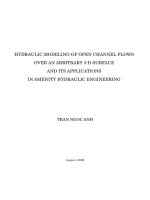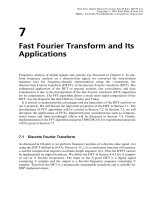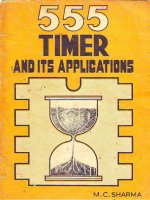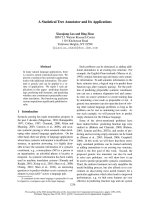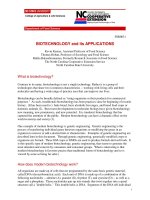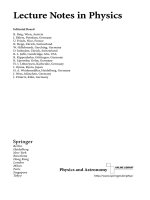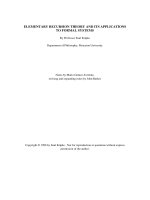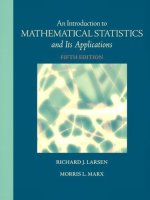Calculus and its applications 13th goldstein
Bạn đang xem bản rút gọn của tài liệu. Xem và tải ngay bản đầy đủ của tài liệu tại đây (9.1 MB, 675 trang )
Thirteenth Edition
CALCULUS
&
ITS APPLICATIONS
Larry J. Goldstein
Goldstein Educational Technologies
David C. Lay
University of Maryland
David I. Schneider
University of Maryland
Nakhl´e H. Asmar
University of Missouri
Boston Columbus Indianapolis New York San Francisco Upper Saddle River
Amsterdam Cape Town Dubai London Madrid Milan Munich Paris Montr´
eal Toronto
Delhi Mexico City S˜
ao Paulo Sydney Hong Kong Seoul Singapore Taipei Tokyo
Editorial Director: Christine Hoag
Editor in Chief: Deirdre Lynch
Executive Editor: Jennifer Crum
Editorial Assistant: Joanne Wendelken
Executive Marketing Manager: Jeff Weidenaar
Marketing Assistant: Caitlin Crain
Executive Content Editor: Christine O’Brien
Senior Managing Editor: Karen Wernholm
Senior Production Supervisor: Ron Hampton
Associate Design Director, Andrea Nix
Interior Design: Cenveo Publisher Services
Art Director/Cover Designer: Beth Paquin
Composition and Project Management: Aptara, Inc.
Senior Technical Art Specialist: Joe Vetere
Procurement Manager: Evelyn M. Beaton
Procurement Specialist: Debbie Rossi
Media Producer: Jean Choe
Software Development: Eileen Moore, MathXL; Marty Wright, TestGen
Cover Image: Origami designed and folded by Sipho Mabona
Many of the designations used by manufacturers and sellers to distinguish their
products are claimed as trademarks. Where those designations appear in this book,
and Pearson was aware of a trademark claim, the designations have been printed in
initial caps or all caps.
Library of Congress Cataloging-in-Publication Data
Calculus and its applications.—13th ed. / Larry J. Goldstein ... [et al.].
p. cm.
Includes bibliographical references and index.
ISBN 0-321-84890-X
1. Calculus—Textbooks. I. Goldstein, Larry Joel. II.
2. Title: Calculus and its applications.
QA303.2.G66 2014
515—dc23
2012021184
Copyright c 2014, 2010, 2007 Pearson Education, Inc. All rights reserved. No part of
this publication may be reproduced, stored in a retrieval system, or transmitted in
any form or by any means, electronic, mechanical, photocopying, recording, or
otherwise, without the prior written permission of the publisher. Printed in the
United States of America. For information on obtaining permission for use of material
in this work, please submit a written request to Pearson Education, Inc. Rights and
Contracts Department, 501 Boylston Street, Boston, MA 02116.
1 2 3 4 5 6 7—CRK—16 15 14 13 12
ISBN-13: 978-0-321-84890-1
ISBN-10: 0-321-84890-X
Contents
Preface vii
Prerequisite Skills Diagnostic Test
Introduction 1
0
xv
Functions
0.1
0.2
0.3
0.4
0.5
0.6
3
Functions and Their Graphs 3
Some Important Functions
13
The Algebra of Functions
21
Zeros of Functions—The Quadratic Formula and Factoring
Exponents and Power Functions
33
Functions and Graphs in Applications 40
Chapter Summary and Chapter Review Exercises
1
50
The Derivative
1.1
1.2
1.3
1.4
1.5
1.6
1.7
1.8
56
The Slope of a Straight Line
57
The Slope of a Curve at a Point 66
The Derivative and Limits 73
Limits and the Derivative
82
Differentiability and Continuity
92
Some Rules for Differentiation 98
More about Derivatives 104
The Derivative as a Rate of Change
112
Chapter Summary and Chapter Review Exercises
2
26
123
Applications of the Derivative
2.1
2.2
2.3
2.4
2.5
2.6
2.7
Describing Graphs of Functions
131
131
The First- and Second-Derivative Rules 141
The First- and Second-Derivative Tests and Curve Sketching
Curve Sketching (Conclusion)
149
159
Optimization Problems 164
Further Optimization Problems 172
Applications of Derivatives to Business and Economics 180
Chapter Summary and Chapter Review Exercises
189
iii
iv
CONTENTS
3
Techniques of Differentiation
3.1
3.2
3.3
The Product and Quotient Rules
197
197
The Chain Rule and the General Power Rule
206
Implicit Differentiation and Related Rates 212
Chapter Summary and Chapter Review Exercises
4
The Exponential and Natural Logarithm Functions
4.1
4.2
4.3
4.4
4.5
4.6
Exponential Functions
The Exponential Function ex
230
Differentiation of Exponential Functions
The Natural Logarithm Function
235
240
The Derivative of ln x 244
Properties of the Natural Logarithm Function
247
Compound Interest
265
Applications of the Natural Logarithm Function to Economics 271
Further Exponential Models 278
287
The Definite Integral
6.1
6.2
6.3
6.4
6.5
291
Antidifferentiation 292
The Definite Integral and Net Change of a Function
300
The Definite Integral and Area under a Graph 308
Areas in the xy-Plane
318
Applications of the Definite Integral 331
Chapter Summary and Chapter Review Exercises
7
256
Exponential Growth and Decay 257
Chapter Summary and Chapter Review Exercises
6
251
Applications of the Exponential and
Natural Logarithm Functions
5.1
5.2
5.3
5.4
339
Functions of Several Variables
7.1
7.2
7.3
7.4
7.5
7.6
226
226
Chapter Summary and Chapter Review Exercises
5
221
347
Examples of Functions of Several Variables 347
Partial Derivatives 353
Maxima and Minima of Functions of Several Variables 361
Lagrange Multipliers and Constrained Optimization
368
The Method of Least Squares 376
Double Integrals
382
Chapter Summary and Chapter Review Exercises
386
CONTENTS
8
The Trigonometric Functions
8.1
8.2
8.3
8.4
392
Radian Measure of Angles 392
The Sine and the Cosine 395
Differentiation and Integration of sin t and cos t
401
The Tangent and Other Trigonometric Functions
409
Chapter Summary and Chapter Review Exercises
9
Integration by Substitution
Integration by Parts
418
419
425
Evaluation of Definite Integrals 429
Approximation of Definite Integrals
432
Some Applications of the Integral 442
Improper Integrals 446
Chapter Summary and Chapter Review Exercises
10
458
Solutions of Differential Equations
458
Separation of Variables 465
First-Order Linear Differential Equations
473
Applications of First-Order Linear Differential Equations
Graphing Solutions of Differential Equations
Applications of Differential Equations
477
484
492
Numerical Solution of Differential Equations 501
Chapter Summary and Chapter Review Exercises
506
Taylor Polynomials and Infinite Series
11.1
11.2
11.3
11.4
11.5
513
Taylor Polynomials 513
The Newton–Raphson Algorithm 520
Infinite Series 527
Series with Positive Terms 534
Taylor Series 540
Chapter Summary and Chapter Review Exercises
12
452
Differential Equations
10.1
10.2
10.3
10.4
10.5
10.6
10.7
11
413
Techniques of Integration
9.1
9.2
9.3
9.4
9.5
9.6
546
Probability and Calculus
12.1
12.2
12.3
12.4
12.5
v
552
Discrete Random Variables 552
Continuous Random Variables
558
Expected Value and Variance
566
Exponential and Normal Random Variables 571
Poisson and Geometric Random Variables 579
Chapter Summary and Chapter Review Exercises
586
vi
CONTENTS
Appendix Areas under the Standard Normal Curve
Learning Objectives A-2
Sources S-1
Answers AN-1
Index of Applications IA-1
Index I-1
A-1
Preface
his thirteenth edition of Calculus and Its Applications, and its Brief version, is
written for either a one- or two-semester applied calculus course. Although this
edition reflects many revisions as requested by instructors across the country, the
foundation and approach of the text has been preserved. In addition, the level of rigor
and flavor of the text remains the same. Our goals for this revision reflect the original
goals of the text which include: to begin calculus as soon as possible; to present calculus
in an intuitive yet intellectually satisfying way; and to integrate the many applications
of calculus to business, life sciences, and social sciences.
This proven approach, as outlined below, coupled with newly updated applications, the integration of tools to make the calculus more accessible to students, and a
greatly enhanced MyMathLab course, make this thirteenth edition a highly effective
resource for your applied calculus courses.
T
The Series
This text is part of a highly successful series consisting of three texts: Finite Mathematics and Its Applications, Calculus and Its Applications, and Brief Calculus and
Its Applications. All three titles are available for purchase as a printed text, an eBook
within the MyMathLab online course, or both.
Topics Included
The distinctive order of topics has proven over the years to be successful. The presentation of topics makes it easier for students to learn, and more interesting because
students see significant applications early in the course. For instance, the derivative is
explained geometrically before the analytic material on limits is presented. To allow
you to reach the applications in Chapter 2 quickly, we present only the differentiation
rules and the curve sketching needed.
Because most courses do not afford enough time to cover all the topics in this text
and because different schools have different goals for the course, we have been strategic
with the placement and organization of topics. To this end, the level of theoretical
material may be adjusted to meet the needs of the students. For example, Section 1.4
may be omitted entirely if the instructor does not wish to present the notion of limit
beyond the required material that is contained in Section 1.3. In addition, sections
considered optional are starred in the table of contents.
Prerequisites
Because students often enter this course with a variety of prerequisite skills, Chapter 0
is available to either cover in its entirety or as a source for remediation depending on
vii
viii
PREFACE
the pace of the course. In addition to being covered in Chapter 0, some important
topics, such as the laws of exponents, are reviewed again when they are used in a later
chapter.
New to this edition, we have added a Prerequisite Skills Diagnostic Test
prior to Chapter 0 so students or instructors can assess weak areas. The answers
to the diagnostic test are provided in the student edition answer section along with
references to areas where students can go for remediation. Remediation is also available
within MyMathLab through the newly created Getting Ready for Applied Calculus
content at the start of select chapters.
New to This Edition
This text has been refined and improved over the past twelve editions via the many
instructor recommendations, student feedback, and years of author experience. However, there are always improvements to be made in the clarity of the exposition, the
relevance of the applications and the quality of exercise sets. To this end, the authors
have worked diligently to fine-tune the presentation of the topics, update the applications, and improve the gradation and thoroughness of the exercise sets throughout the
text. In addition, there are a few topics that the authors focused on to better enhance
the learning experience for students.
r The Derivative (Chapter 1) In the previous edition, the derivative is introduced in Section 1.3 in an intuitive way, using examples of slopes of tangent lines
and applied problems involving rates of change from Section 1.2. In the current
edition, Section 1.3 incorporates an intuitive introduction to limits, as they arise
from the computations of derivatives. This approach to limits paves the way to
the more detailed discussion on limits in Section 1.4. It offers the instructor the
option of spending less time on limits (and therefore more time on the application)
by not emphasizing or completely skipping Section 1.4.
r The Integral (Chapter 6) Chapter 6 has been significantly reworked. As in the
previous edition, we introduce the antiderivative in Section 6.1. However, we have
simplified the presentation in Section 6.1 by opening with an example involving
the velocity and position functions of a moving object. This example motivates the
introduction of the antiderivative or indefinite integral in a natural way. Section 6.2
builds on the momentum from the examples of antiderivatives and introduces the
definite integral using the formula
b
f (x) dx = F (b) − F (a),
a
where F is an antiderivative of f . Several new examples are presented in Section 6.2 that illustrate the importance of the definite integral and the use of the
antiderivative (net change in position, marginal revenue analysis, net increase in
federal health expenditures).
In Section 6.3, we introduce the concepts of Riemann sums and areas of regions under a graph, and prove the Fundamental Theorem of Calculus by showing
that the Riemann sums converge to the definite integral. Our new approach allows
for an easier flow of the discussion of integration by moving directly from the indefinite integral to the definite integral, without the diversion into Riemann sums.
While the classical approach to the definite integral (as a limit of Riemann sums)
has the concepts of limits and area as a driver, our approach emphasizes the applications as the driver for the definite integral. More importantly, our new approach
allows students to compute areas using basic geometric formulas (areas of rectangles and right triangles) and compare their results to those obtained by using the
definite integral. In contrast to the approach based on limits of Riemann sums,
our approach provides a hands-on approach to areas and brings students closer
to understanding the concept of Riemann sums and areas. (See the Introduction
and Example 1 in Section 6.3.)
PREFACE
ix
r Prerequisite Skills Diagnostic Test A quick assessment of the basic algebra
skills students should already have mastered is provided prior to Chapter 0. This
can be a self-diagnostic tool for students, or instructors can use it to gain a sense
of where review for the entire class may be helpful. Answers are provided in the
back of the student edition along with references to where students can go for
remediation within the text.
r Now Try Exercises Students are now given Now Try exercises to encourage an
immediate check of their understanding of a given example by solving a specific,
odd-numbered exercise from the exercise sets.
r Additional Exercises and Updated Applications We have added many new
exercises and have updated the real-world data appearing in the examples and
exercises whenever possible.
r Chapter Summaries Each chapter ends with a summary that directs students
to the important topics in the sections. In addition, we have identified topics that
may be challenging to students and presented several helpful examples. Most notably, we have added examples that illustrate differentiation and integration rules,
integration by parts, solving optimization problems, setting up equations arising
from modeling, solving problems involving functions of more than one variable
(Lagrange multiplier, second derivative test in two dimensions), and differential
equations, to name just a few. Effectively, the summaries contain more than one
hundred additional, completely worked examples.
r Answers to Fundamental Concept Check Exercises We have added the
answers to the Fundamental Concept Check Exercises so students can check their
understanding of the main concepts in each chapter.
r Chapter Objectives The key learning objectives for each section of the text are
enumerated in the back of the text. These objectives will be especially helpful for
instructors who need to verify that particular skills are covered in the text.
r Summary Endpapers A two-page spread at the back of the text lists key definitions, theorems and formulas from the course for an easy reference guide for
students.
New Resources Outside the Text
1. Annotated Instructor’s Edition New to this edition, an annotated instructor’s edition is available to qualified adopters of the text. The AIE is a highly
valuable resource for instructors with answers to the exercises on the same page
as the exercise, whenever possible, making it easier to assign homework based
on the skill level and interests of each class. Teaching Tips are also provided in
the AIE margins to highlight for new instructors the common pitfalls made by
students.
2. Updates to MyMathLab (MML) Many improvements have been made to
the overall functionality of MML since the previous edition. However, beyond that,
we have also invested greatly in increasing and improving the content specific to
this text.
a. Instructors now have more exercises to choose from in assigning homework.
b. An extensive evaluation of individual exercises in MML has resulted in minor
edits and refinements making for an even stronger connection between
the exercises available in the text with the exercises available in MML.
c. Interactive Figures have been developed specifically for this text as a
way to provide students with a visual representation of the mathematics.
These interactive figures are integrated into the eText for student use, available in the instructor’s resources as a presentational tool, and are tied to
specifically designed exercises in MyMathLab for targeted instruction and
assessment. The Interactive Figures run on the freely available Wolfram CDF
Player.
x
PREFACE
d. Application exercises in MML are now labeled with the field of study to
which they relate. This allows instructors to design online homework assignments more specific to the students’ fields of study (i.e., Bus Econ; Life Sci;
Social Sci; Gen Interest)
e. Because students’ struggles with prerequisite algebra skills are the most serious roadblock to success in this course, we have added “Getting Ready”
content to the beginning of chapters in MML. These introductory sections
contain the prerequisite algebra skills critical for success in that chapter.
Instructors can either sprinkle these exercises into homework assignments as
needed or use MML’s built-in diagnostic tests to assess student knowledge of
these skills, then automatically assign remediation for only those skills that
students have not mastered (using the Personalized Homework functionality). This assessment tied to personalized remediation provides an extremely
valuable tool for instructors, and help “just in time” for students.
Trusted Features
Though this edition has been improved in a variety of ways to reflect changing student
needs, we have maintained the popular overall approach that has helped students be
successful over the years.
Relevant and Varied Applications
We provide realistic applications that illustrate the uses of calculus in other disciplines
and everyday life. The reader may survey the variety of applications by referring to
the Index of Applications at the end of the text. Wherever possible, we attempt to use
applications to motivate the mathematics. For example, our approach to the derivative
in Section 1.3 is motivated by the slope formula and applications in Section 1.2, and
applications of the net change of functions in Section 6.2 motivate our approach to
the integral in 6.3.
Plentiful Examples
The text provides many more worked examples than is customary. Furthermore, we
include computational details to enhance comprehension by students whose basic skills
are weak. Knowing that students often refer back to examples for help as they work
through exercises, we closely reviewed the fidelity between exercises and examples
in this revision, making adjustments as necessary to create a better resource for the
students.
Exercises to Meet All Student Needs
The exercises comprise about one-quarter of the book, the most important part
of the text, in our opinion. The exercises at the ends of the sections are typically
arranged in the order in which the text proceeds, so that homework assignments may
be made easily after only part of a section is discussed. Interesting applications and
more challenging problems tend to be located near the ends of the exercise sets. An
additional effort has been made in this edition to create an even stronger odd-even
pairing between exercises, when appropriate. Chapter Review Exercises at the end
of each chapter amplify the other exercise sets and provide cumulative exercises that
require skills acquired from earlier chapters. Answers to the odd-numbered exercises,
and all Chapter Review Exercises, are included at the back of the book.
Check Your Understanding Problems
The Check Your Understanding Problems, formerly called Practice Problems,
are a popular and useful feature of the book. They are carefully selected exercises
located at the end of each section, just before the exercise set. Complete solutions
PREFACE
xi
follow the exercise set. These problems prepare students for the exercise sets beyond
just covering prerequisite skills or simple examples. They give students a chance to
think about the skills they are about to apply and reflect on what they’ve learned.
Use of Technology
As in previous editions, the use of graphing calculators is not required for the study
of this text; however graphing calculators are very useful tools that can be used to
simplify computations, draw graphs, and sometimes enhance understanding of the fundamental topics of calculus. Helpful information about the use of calculators appears
at the end of most sections in subsections titled Incorporating Technology. The
examples have been updated to illustrate the use of the family of TI-83/84 calculators,
in particular, most screenshots display in MathPrint mode from the new TI-84+ Silver
Edition.
End-of-Chapter Study Aids
Near the end of each chapter is a set of problems entitled Fundamental Concept Check
Exercises that help students recall key ideas of the chapter and focus on the relevance
of these concepts as well as prepare for exams. The answers to these exercises are
now included in the back-of-book student answer section. Each chapter also contains
a new two-column grid giving a section-by-section summary of key terms and concepts
with examples. Finally, each chapter has Chapter Review Exercises that provide more
practice and preparation for chapter-level exams.
xii
PREFACE
Supplements
For Students
For Instructors
Student’s Solutions Manual
(ISBN: 0-321-87857-4/978-0-321-87857-1)
Contains fully worked solutions to odd-numbered exercises.
Annotated Instructor’s Edition
(ISBN: 0-321-86461-1/978-0-321-86461-1)
New to this edition, the Annotated Instructor’s Edition
provides answers to the section exercises on the page whenever
possible. In addition, Teaching Tips provide insightful
comments to those who are new to teaching the course.
Video Lectures with Optional Captioning (online)
These comprehensive, section-level videos provide excellent
support for students who need additional assistance, for
self-paced or online courses, or for students who missed class.
The videos are available within MyMathLab at both the
section level, as well as at the example level within the eText.
Instructor’s Solutions Manual (downloadable)
Includes fully worked solutions to every textbook exercise.
Available for download for qualified instructors within
MyMathLab or through the Pearson Instructor Resource
Center, www.pearsonhighered.com/irc.
PowerPoint Lecture Presentation
Contains classroom presentation slides that are geared
specifically to the textbook and contain lecture content and
key graphics from the book. Available to qualified instructors
within MyMathLab or through the Pearson Instructor
Resource Center, www.pearsonhighered.com/irc.
R
TestGen (downloadable)
TestGen (www.pearsoned.com/testgen) enables instructors to
build, edit, print, and administer tests using a computerized
bank of questions developed to cover all the objectives of the
text. TestGen is algorithmically based, allowing instructors to
create multiple but equivalent versions of the same question
or test with the click of a button. Instructors can also modify
test bank questions or add new questions. The software and
testbank are available for download from Pearson Education’s
online catalog, www.pearsonhighered.com/irc.
Media Supplements for Students and Instructors
R
MyMathLab Online Course (access code required)
MyMathLab from Pearson is the world’s leading online resource in mathematics, integrating interactive homework,
assessment, and media in a flexible, easy-to-use format.
r MyMathLab has a consistently positive impact on the quality of learning in higher
education math instruction. MyMathLab can be successfully implemented in any
environment—lab-based, hybrid, fully online, traditional—and creates a quantifiable difference with integrated usage has on student retention, subsequent success, and overall
achievement.
r MyMathLab’s comprehensive online gradebook automatically tracks your students’ results
on tests, quizzes, homework, and in the study plan. You can use the gradebook to quickly
intervene if your students have trouble, or to provide positive feedback on a job well done.
The data within MyMathLab is easily exported to a variety of spreadsheet programs, such
as Microsoft Excel. You can determine which points of data you want to export, and then
analyze the results to determine success.
MyMathLab provides engaging experiences that personalize, stimulate, and measure learning for each student.
r Exercises: The homework and practice exercises in MyMathLab are correlated to the
exercises in the textbook, and they regenerate algorithmically to give students unlimited
opportunity for practice and mastery. The software offers immediate, helpful feedback when
students enter incorrect answers.
r Multimedia Learning Aids: Exercises include guided solutions, sample problems,
animations, videos, interactive figures, and eText access for extra help at point of use.
PREFACE
xiii
r Getting Ready Content: Prerequisite skills content is now provided chapter by chapter within MyMathLab. You can include this content as needed within regular homework
assignments or use MyMathLab’s built-in diagnostic tests to assess gaps in skills and automatically assign remediation to address those gaps.
r Expert Tutoring: Although many students describe the whole of MyMathLab as “like
having your own personal tutor,” students using MyMathLab do have access to live tutoring
from Pearson, from qualified math and statistics instructors.
And, MyMathLab comes from a trusted partner with educational expertise and an eye on the future.
r Knowing that you are using a Pearson product means knowing that you are using quality
content. That means that our eTexts are accurate and our assessment tools work. It means
we are committed to making MyMathLab as accessible as possible. Whether you are just
getting started with MyMathLab, or have a question along the way, we’re here to help you
learn about our technologies and how to incorporate them into your course.
To learn more about how MyMathLab combines proven learning applications with powerful assessment, visit
www.mymathlab.com or contact your Pearson representative.
MyMathLab R Ready-to-Go Course (access code required)
These new Ready-to-Go courses provide students with all the same great MyMathLab features, but make it easier for instructors
to get started. Each course includes pre-assigned homework and quizzes to make creating a course even simpler. Ask your Pearson
representative about the details for this particular course or to see a copy of this course.
MyMathLab R Plus (access code required)
Combines proven results and engaging experiences from MyMathLab R with convenient management tools and a dedicated
services team. Designed to support growing math programs, it includes additional features such as
r Batch Enrollment: Your school can create the login name and password for every student
and instructor, so everyone can be ready to start class on the first day. Automation of this
process is also possible through integration with your school’s Student Information System.
r Login from Your Campus Portal: You and your students can link directly from your
campus portal into your MyLabsPlus courses. A Pearson service team works with your
institution to create a single sign-on experience for instructors and students.
r Advanced Reporting: Advanced reporting allows instructors to review and analyze students’ strengths and weaknesses by tracking their performance on tests, assignments, and
tutorials. Administrators can review grades and assignments across all MyMathLab Plus
courses on your campus for a broad overview of program performance.
r 24/7 Support: Students and instructors receive 24/7 support, 365 days a year, by email
or online chat.
Available to qualified adopters. For more information, visit our website at www.mylabsplus.com or
contact your Pearson representative.
MathXL R Online Course (access code required)
MathXL is the homework and assessment engine that runs MyMathLab. (MyMathLab is MathXL plus a
learning management system.)
With MathXL, instructors can
r Create, edit, and assign online homework and tests using algorithmically generated
exercises correlated at the objective level to the textbook.
r Create and assign their own online exercises and import TestGen tests for added flexibility.
r Maintain records of all student work tracked in MathXL’s online gradebook.
With MathXL, students can
r Take chapter tests in MathXL and receive personalized study plans and/or personalized
homework assignments based on their test results.
r Use the study plan and/or the homework to link directly to tutorial exercises for the
objectives they need to study.
r Access supplemental animations and video clips directly from selected exercises.
MathXL is available to qualified adopters. For more information, visit our website at www.mathxl.com or
contact your Pearson representative.
xiv
PREFACE
Acknowledgments
While writing this book, we have received assistance from many people, and our
heartfelt thanks go out to them all. Especially, we should like to thank the following
reviewers, who took the time and energy to share their ideas, preferences, and often
their enthusiasm, with us during this revision.
John G. Alford, Sam Houston State University
Christina Bacuta, University of Delaware
Kimberly M. Bonacci, Indiana University Southeast
Linda Burns, Washington University St. Louis
Sarah Clark, South Dakota State University
Joel M. Cohen, University of Maryland
Leslie Cohn, The Citadel
Elaine B. Fitt, Bucks County Community College
Shannon Harbert, Linn Benton Community College
Frederick Hoffman, Florida Atlantic University
Jeremiah W. Johnson, Pennsylvania State University, Harrisburg
Houshang Kakavand, Erie Community College
Erin Kelly, California Polytechnic State University–San Luis Obispo
Nickolas Kintos, Saint Peter’s College
Cynthia Landrigan, Erie Community College–South
Alun L. Lloyd, North Carolina State University
Jack Narayan, SUNY Oswego
Robert I. Puhak, Rutgers University
Brooke P. Quinlan, Hillsborough Community College
Mary Ann Teel, University of North Texas
Jeffrey Weaver, Baton Rouge Community College
We wish to thank the many people at Pearson who have contributed to the success of this book. We appreciate the efforts of the production, art, manufacturing,
marketing, and sales departments. We are grateful to Paul Lorczak, Debra McGivney,
Theresa Schille, Lynn Ibarra, Damon Demas, and John Samons for their careful and
thorough accuracy checking. Production Supervisor Ron Hampton did a fantastic job
keeping the book on schedule. The authors wish to extend a special thanks to Christine
O’Brien and Jenny Crum.
If you have any comments or suggestions, we would like to hear from you. We
hope you enjoy using this book as much as we have enjoyed writing it.
Larry J. Goldstein
David C. Lay
David I. Schneider
Nakhl´e H. Asmar
Prerequisite Skills
Diagnostic Test
To the Student and the Instructor Are you ready for calculus? This prerequisite skills diagnostic test evaluates
basic mathematical skills that are required to begin the course. It is not intended to replace a placement test that your
institution may already have. Each set of questions refers to a section in Chapter 0 of the text. If you miss several
questions from one part, you may want to study the corresponding section from Chapter 0.
Calculate the given quantities using the laws of exponents. (Section 0.5)
√
73/2 √
3
7
2. (31/3 31/2 )2 3
1.
49
3. √
√
5
√
15 3
4. 21/3 21/2 21/6
Simplify the given expressions. Your answer should not involve parentheses or negative exponents. (Section 0.5)
5.
x2
x−4
7.
x
x2 y 2
6.
3
y8
8.
x2 (x−4 + 1)
x−2
1
xy
−2
x
y
2
x
and g(x) = x + 1, express the following as a rational functions. (Section 0.3)
x+1
9. f (x) + g(x)
10. f (x)g(x)
Given f (x) =
11.
g(x)
f (x)
12. f (x) −
Given f (t) = t2 and g(t) =
g(x)
x+1
t
, calculate the following functions. Simplify your answer as much as possible.
t+1
(Section 0.3)
13. f (g(t))
14. g(f (t))
15. f (f (g(t)))
16. f (g(t + 1))
For the given f (x), find
17. f (x) = x2 + 2x
19. f (x) =
√
f (x + h) − f (x)
and simplify your answer as much as possible. (Section 0.3)
h
1
18. f (x) =
x
x (Hint: Rationalize the numerator.)
20. f (x) = x3 − 1
xv
xvi
PREREQUISITE SKILLS DIAGNOSTIC TEST
Graph the following functions. Determine clearly the intercepts of the graphs. (Section 0.2)
21. f (x) = 2x − 1
23. f (x) = −
x−1
2
22. f (x) = −x
24. f (x) = 3
Find the points of intersection (if any) of the pairs of curves. (Section 0.4)
x
25. y = 3x + 1, y = −x − 2
26. y = , y = 3
2
27. y = 4x − 7, y = 0
28. y = 2x + 3, y = 2x − 2
Factor the given polynomials. (Section 0.4)
29. x2 + 5x − 14
30. x2 + 5x + 4
31. x3 + x2 − 2x
32. x3 − 2x2 − 3x
Solve the given equations by factoring first. (Section 0.4)
33. x2 − 144 = 0
34. x2 + 4x + 4 = 0
35. x3 + 8x2 + 15x = 0
36. 6x3 + 11x2 + 3x = 0
Solve using the quadratic formula. (Section 0.4)
37. 2x2 + 3x − 1 = 0
38. x2 + x − 1 = 0
39. −3x2 + 2x − 4 = 0
40. x2 + 4x − 4 = 0
Solve the given equations. (Section 0.4)
41. x2 − 3x = 4x − 10
43.
1
=x+1
x+1
42. 4x2 + 2x = −2x + 3
44.
x3
=x−1
x2 + 2x − 1
Introduction
“Calculus provides
mathematical tools to
study each change in
a quantitative way.”
ften, it is possible to give a succinct and revealing description of a situation
by drawing a graph. For example, Fig. 1 describes the amount of money in
a bank account drawing 5% interest, compounded daily. The graph shows that, as
time passes, the amount of money in the account grows. Figure 2 depicts the weekly
sales of a breakfast cereal at various times after advertising has ceased. The graph
shows that the longer the time since the last advertisement, the fewer the sales.
Figure 3 shows the size of a bacteria culture at various times. The culture grows
larger as time passes. But there is a maximum size that the culture cannot exceed.
This maximum size reflects the restrictions imposed by food supply, space, and similar
factors. The graph in Fig. 4 describes the decay of the radioactive isotope iodine 131.
As time passes, less and less of the original radioactive iodine remains.
O
500
400
300
200
100
5
10
15 20 25
Time (years)
Figure 1 Growth of money in a
savings account.
30
t
Sales (100,000’s of boxes)
Amount of money
y
4
3
2
1
1
2
3
Time (months)
4
Figure 2 Decrease in sales of
breakfast cereal.
1
18
15
Maximum
culture size
12
9
6
3
12
24
36 48 60
Time (hours)
72
Figure 3 Growth of a bacteria culture.
Quantity of iodine 131 (grams)
Introduction
Culture size (millions)
2
y
50
40
30
20
10
5
10
15 20 25
Time (days)
30
t
Figure 4 Decay of radioactive iodine.
Each graph in Figs. 1 to 4 describes a change that is taking place. The amount
of money in the bank is changing, as are the sales of cereal, the size of the bacteria
culture, and the amount of iodine. Calculus provides mathematical tools to study each
change in a quantitative way.
0
CHAPTER
Functions
0.1
Functions and Their Graphs
0.2
Some Important Functions
0.3
The Algebra of Functions
0.4
Zeros of Functions—The Quadratic Formula
and Factoring
0.5
Exponents and Power Functions
0.6
Functions and Graphs in Applications
ach graph in Figs. 1 to 4 of the Introduction depicts a relationship between two
quantities. For example, Fig. 4 illustrates the relationship between the quantity of
iodine (measured in grams) and time (measured in days). The basic quantitative tool
for describing such relationships is a function. In this preliminary chapter, we develop
the concept of a function and review important algebraic operations on functions used
later in the text.
E
0.1
Functions and Their Graphs
Real Numbers
Most applications of mathematics use real numbers. For purposes of such applications
(and the discussions in this text), it suffices to think of a real number as a decimal. A
rational number is one that may be written as a finite or infinite repeating decimal or
as a fraction, such as
−
5
= −2.5,
2
13
= 4.333 . . .
3
1,
(rational numbers).
An irrational number has an infinite decimal representation whose digits form no
repeating pattern, such as
√
− 2 = −1.414213 . . . ,
π = 3.14159 . . . (irrational numbers).
The real numbers are described geometrically by a number line, as in Fig. 1. Each
number corresponds to one point on the line, and each point determines one real
number.
Figure 1 The real
number line.
−5
2
−4
−3
− 2
−2
−1
13
3
π
0
1
2
3
4
3
4
CHAPTER 0 Functions
We use four types of inequalities to compare real numbers.
x
x is less than y
x≤y
x is less than or equal to y
x>y
x is greater than y
x≥y
x is greater than or equal to y
The double inequality a < b < c is shorthand for the pair of inequalities a < b and
b < c. Similar meanings are assigned to other double inequalities, such as a ≤ b < c.
Three numbers in a double inequality, such as 1 < 3 < 4 or 4 > 3 > 1, should have
the same relative positions on the number line as in the inequality (when read left to
right or right to left). Thus 3 < 4 > 1 is never written because the numbers are “out
of order.”
Geometrically, the inequality x ≤ b means that either x equals b or x lies to the left
of b on the number line. The set of real numbers x that satisfies the double inequality
a ≤ x ≤ b corresponds to the line segment between a and b, including the endpoints.
This set is sometimes denoted by [a, b] and is called the closed interval from a to b.
If a and b are removed from the set, the set is written as (a, b) and is called the open
interval from a to b. The notation for various line segments is listed in Table 1.
TABLE 1 Intervals on the Number Line
Inequality
a≤x≤b
Geometric Description
Interval Notation
[a, b]
a
b
a
b
a≤x
a
b
a
a
b
a≤x
a
[a, ∞)
a
(a, ∞)
a
a
x
b
b
(a, b)
[a, b)
(a, b]
(−∞, b]
(−∞, b)
The symbols ∞ (“infinity”) and −∞ (“minus infinity”) do not represent actual real
numbers. Rather, they indicate that the corresponding line segment extends infinitely
far to the right or left. An inequality that describes such an infinite interval may be
written in two ways. For instance, a ≤ x is equivalent to x ≥ a.
EXAMPLE 1
SOLUTION
EXAMPLE 2
Graphing Intervals Describe each of the following intervals both graphically and in
terms of inequalities.
√
(a) (−1, 2)
(b) [−2, π]
(c) (2, ∞)
(d) (−∞, 2 ]
The line segments corresponding to the intervals are shown in Figs. 2(a)–(d). Note
that an interval endpoint that is included (e.g., both endpoints of [a, b]) is drawn as a
solid circle, whereas an endpoint not included (e.g., the endpoint a in (a, b]) is drawn
as an unfilled circle.
Using Inequalities The variable x describes the profit that a company anticipates
earning in the current fiscal year. The business plan calls for a profit of at least
5 million dollars. Describe this aspect of the business plan in the language of intervals.
0.1 Functions and Their Graphs
−3
−3
−2
−2
−1
0
1
2
3
−3
−2
−1
0
1
−1 < x < 2
−2 ≤ x ≤ π
(a)
(b)
−1
0
1
2
3
−3
−2
2
−1
1 2 2
√
−∞ < x ≤ 2
(c)
0
2
5
3π
3
(d)
Figure 2 Line segments.
SOLUTION
The phrase “at least” means “greater than or equal to.” The business plan requires
that x ≥ 5 (where the units are millions of dollars). This is equivalent to saying that
x lies in the infinite interval [5, ∞).
Functions A function of a variable x is a rule f that assigns to each value of x
a unique number f (x), called the value of the function at x. [We read “f (x)” as “f
of x.”] The variable x is called the independent variable. The set of values that the
independent variable is allowed to assume is called the domain of the function. The
domain of a function may be explicitly specified as part of the definition of a function,
or it may be understood from context. (See the following discussion.) The range of a
function is the set of values that the function assumes.
The functions we shall meet in this book will usually be defined by algebraic
formulas. For example, the domain of the function
f (x) = 3x − 1
consists of all real numbers x. This function is the rule that takes a number, multiplies
it by 3, and then subtracts 1. If we specify a value of x—say, x = 2—then we find the
value of the function at 2 by substituting 2 for x in the formula:
f (2) = 3(2) − 1 = 5.
EXAMPLE 3
Evaluating a Function Let f be the function with domain all real numbers x and
defined by the formula
f (x) = 3x3 − 4x2 − 3x + 7.
Find f (2) and f (−2).
SOLUTION
To find f (2), we substitute 2 for every occurrence of x in the formula for f (x):
f (2) = 3(2)3 − 4(2)2 − 3(2) + 7
= 3(8) − 4(4) − 3(2) + 7
= 24 − 16 − 6 + 7
= 9.
To find f (−2), we substitute (−2) for each occurrence of x in the formula for f (x).
The parentheses ensure that the −2 is substituted correctly. For instance, x2 must be
replaced by (−2)2 , not −22 :
f (−2) = 3(−2)3 − 4(−2)2 − 3(−2) + 7
= 3(−8) − 4(4) − 3(−2) + 7
= −24 − 16 + 6 + 7
= −27.
Now Try Exercise 13
6
CHAPTER 0 Functions
EXAMPLE 4
SOLUTION
Temperature Scales If x represents the temperature of an object in degrees Celsius,
then the temperature in degrees Fahrenheit is a function of x, given by f (x) = 95 x + 32.
(a) Water freezes at 0 ◦ C (C = Celsius) and boils at 100 ◦ C. What are the corresponding temperatures in degrees Fahrenheit (F = Fahrenheit)?
(b) Aluminum melts at 660 ◦ C. What is its melting point in degrees Fahrenheit?
(a) f (0) = 95 (0) + 32 = 32. Water freezes at 32 ◦ F.
f (100) = 95 (100) + 32 = 180 + 32 = 212. Water boils at 212 ◦ F.
(b) f (660) = 95 (660) + 32 = 1188 + 32 = 1220. Aluminum melts at 1220 ◦ F.
In the preceding examples, the functions had domains consisting of all real numbers or an interval. For some functions, the domain may consist of several intervals,
with a different formula defining the function on each interval. Here is an illustration
of this phenomenon.
EXAMPLE 5
A Piecewise-Defined Function A leading brokerage firm charges a 6% commission on
gold purchases in amounts from $50 to $300. For purchases exceeding $300, the firm
charges 2% of the amount purchased plus $12.00. Let x denote the amount of gold
purchased (in dollars) and let f (x) be the commission charge as a function of x.
(a) Describe f (x).
(b) Find f (100) and f (500).
SOLUTION
(a) The formula for f (x) depends on whether 50 ≤ x ≤ 300 or 300 < x. When
50 ≤ x ≤ 300, the charge is .06x dollars. When 300 < x, the charge is .02x + 12.
The domain consists of the values of x in one of the two intervals [50, 300] and
(300, ∞). In each of these intervals, the function is defined by a separate formula:
f (x) =
.06x
.02x + 12
for 50 ≤ x ≤ 300
for 300 < x.
Note that an alternative description of the domain is the interval [50, ∞). That
is, the value of x may be any real number greater than or equal to 50.
(b) Since x = 100 satisfies 50 ≤ x ≤ 300, we use the first formula for f (x): f (100) =
.06(100) = 6. Since x = 500 satisfies 300 < x, we use the second formula for f (x):
f (500) = .02(500) + 12 = 22.
Now Try Exercise 57
In calculus, it is often necessary to substitute an algebraic expression for x and
simplify the result, as illustrated in the following example.
EXAMPLE 6
SOLUTION
Evaluating a Function
If f (x) = (4 − x)/(x2 + 3), what is f (a)? f (a + 1)?
Here, a represents some number. To find f (a), we substitute a for x wherever x appears
in the formula defining f (x):
4−a
.
f (a) = 2
a +3
To evaluate f (a + 1), substitute a + 1 for each occurrence of x in the formula for f (x):
f (a + 1) =
4 − (a + 1)
.
(a + 1)2 + 3
We can simplify the expression for f (a+1) using the fact that (a+1)2 = (a+1)(a+1) =
a2 + 2a + 1:
4 − (a + 1)
4−a−1
3−a
f (a + 1) =
= 2
= 2
.
(a + 1)2 + 3
a + 2a + 1 + 3
a + 2a + 4
More about the Domain of a Function When defining a function, it is necessary
to specify the domain of the function, which is the set of acceptable values of the
variable. In the preceding examples, we explicitly specified the domains of the functions
0.1 Functions and Their Graphs
7
considered. However, throughout the remainder of the text, we will usually mention
functions without specifying domains. In such circumstances, we will understand the
intended domain to consist of all numbers for which the defining formula(s) makes
sense. For example, consider the function
f (x) = x2 − x + 1.
The expression on the right may be evaluated for any value of x. So, in the absence
of any explicit restrictions on x, the domain is understood to consist of all numbers.
As a second example, consider the function
f (x) =
1
.
x
Here x may be any number except zero. (Division by zero is not permissible.) So the
domain intended is the set of nonzero numbers. Similarly, when we write
√
f (x) = x,
we understand the domain of f (x) to be the set of all nonnegative numbers, since the
square root of a number x is defined if and only if x ≥ 0.
EXAMPLE 7
SOLUTION
Domains of Functions
√
(a) f (x) = 4 + x
Find the domains of the following functions:
√
√
1
(b) g(x) = √
(c) h(x) = 1 + x − 1 − x
1 + 2x
(a) Since we cannot take the square root of a negative number, we must have
4 + x ≥ 0, or equivalently, x ≥ −4. So the domain of f is [−4, ∞).
(b) Here, the domain consists of all x for which
1 + 2x > 0
2x > −1
1
x>−
2
Simplifying
Dividing both sides by 2.
The domain is the open interval (− 12 , ∞).
(c) In order to be able to evaluate both square roots that appear in the expression of
h(x), we must have
1 + x ≥ 0 and
1 − x ≥ 0.
The first inequality is equivalent to x ≥ −1, and the second one to x ≤ 1. Since
x must satisfy both inequalities, it follows that the domain of h consists of all x
for which −1 ≤ x ≤ 1.
Now Try Exercise 25
Graphs of Functions Often it is helpful to describe a function f geometrically,
using a rectangular xy-coordinate system. Given any x in the domain of f , we can
plot the point (x, f (x)). This is the point in the xy-plane whose y-coordinate is the
value of the function at x. The set of all such points (x, f (x)) usually forms a curve
in the xy-plane and is called the graph of the function f (x).
It is possible to approximate the graph of f (x) by plotting the points (x, f (x)) for
a representative set of values of x and joining them by a smooth curve. (See Fig. 3.)
The more closely spaced the values of x, the closer the approximation.
EXAMPLE 8
SOLUTION
Sketching a Graph by Plotting Points Sketch the graph of the function f (x) = x3 .
The domain consists of all numbers x. We choose some representative values of x and
tabulate the corresponding values of f (x). We then plot the points (x, f (x)) and draw
a smooth curve through the points. (See Fig. 4.)
8
CHAPTER 0 Functions
y
30
25
20
x
0
1
2
3
−1
−2
−3
y
(5, f(5))
(−2, f(−2))
f(x) =
(1, f(1))
y = x3
15
x3
10
0
1
8
27
−1
−8
−27
5
x
−4 −3 −2
1
−5
2
3
4
−10
−15
−20
(3, f(3))
−25
−30
x
−3 −2 −1
1
2
3
4
5
Figure 4 Graph of f (x) = x3 .
Figure 3
EXAMPLE 9
SOLUTION
A Graph with a Restricted Domain Sketch the graph of the function f (x) = 1/x.
The domain of the function consists of all numbers except zero. The table in Fig. 5
lists some representative values of x and the corresponding values of f (x). A function
often has interesting behavior for x near a number not in the domain. So, when we
chose representative values of x from the domain, we included some values close to
zero. The points (x, f (x)) are plotted and the graph sketched in Fig. 5.
y
x
1
4
1
2
4
2
x
f(x) =
1
−
4
1
−
2
−4
−2
1
1
−1
−1
2
1
2
1
3
1
4
−2
−
3
4
Figure 5 Graph of
f (x) = x1 .
f(x) =
1
x
−3
−4
1
2
1
−
3
1
−4
1
x
y=
1
x
1
1
2
3
x
Now that graphing calculators and computer graphing programs are widely available, we seldom need to sketch graphs by hand-plotting large numbers of points on
graph paper. However, to use such a calculator or program effectively, we must know
in advance which part of a curve to display. Critical features of a graph may be missed
or misinterpreted if, for instance, the scale on the x- or y-axis is inappropriate.
An important use of calculus is to identify key features of a function that should
appear in its graph. In many cases, only a few points need be plotted, and the general
shape of the graph is easy to sketch by hand. For more complicated functions, a
graphing program is helpful. Even then, calculus provides a way of checking that
the graph on the computer screen has the correct shape. Algebraic calculations are
usually part of the analysis. The appropriate algebraic skills are reviewed in this
chapter.
